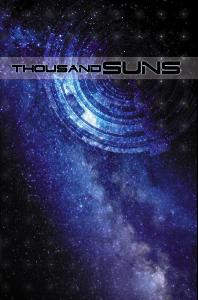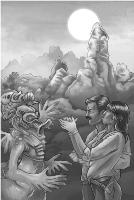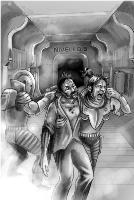
Product Name: Thousand Suns
Publisher: Rogue Games
Author: James Maliszewski, Richard Iorio II
System: 12°
Setting: Thousand Suns
Theme: Space Opera, Sci-Fi
Type: Core
Link: http://www.rogue-games.net/
Thousand Suns is a flexible science-fiction framework influenced by sci-fi writings and ideas from the 1950’s, 60’s, and 70’s, which Rogue Games refers to as Imperial Science-Fiction, and is powered by the 12° system. The rules are meant to create an atmosphere that allows the Game Master (GM) to create virtually any setting imaginable based off a handful of ideas and events that set the scene for that setting.
While the framework is very similar to the Traveller role-playing game, the mechanics are much more simple and easy to use. The content within creates the framework, without limiting the options available, to produce the minute details as the GM desires. Thousand Suns is filled with imagination, dynamic themes, and a plethora of tools and source material that any GM can use to create their own unique setting. The mechanics fit well within the system and present a wealth of options for great role-play, colorful combat, and more planetary discovery than imaginable.
BASICS
Thousand Suns starts of with an introductory to the setting, the system, and the ideas surrounding how Thousand Suns was designed. The first explanation which truly lays a great framework to understanding the rest of the content, is the explanation for how the game was designed. As noted, Thousand Suns is influenced by Sci-Fi from the 50’s, 60’s, and 70’s, and places them into a system that is more of a sandbox then a definitive setting where players and GMs are meant to play. While seemingly unimportant, it helps to understand why the content is presented the way it’s presented. The material within is there to give the GM ideas, plot-hooks, and storyline assistance without confining them to a previously created setting. The result is a Space Opera-style science-fiction atmosphere which feels like the classic science-fiction of old.
The book then continues with the introduction and explanation of the 12° system. 12° is a roll-under system using 2d12 where the target number (TN) is based off the characters’ own skills and abilities. Thus, the more skilled and able the character becomes, the better their chances are for success. The basics of the system are explained including Skill Tests, Opposed Skill Tests, Degrees of Success, Modifiers, and Hooks and Action Points. This is all standard and similar to the explanations from Colonial Gothic, although I found myself being less confused with the explanations found within Thousand Suns. I feel the introduction of the system was improved and the small snafu’s have been corrected.
CHARACTER CREATION
The second chapter moves quickly into Character Creation. The book starts by further explaining the details of the 12° system including Abilities, Species, Homeworld, Career, and Hooks. Some of these are slightly different than the Colonial Gothic system as they are meant to represent a Sci-Fi setting as opposed to the Colonial America Horror setting. I find the introduction to be refined and presented in a much better way including a complete lack of conflicting statements, more details, easier to follow explanations, and a wealth of new options.

Character Creation then moves on to choosing a species. While there are only a handful of non-human species introduced here, they provide a good standard and outline for a GM to use to create their own species if so desired. Each species is not only detailed but also include racial features, traits, a brief history, and of course the associated bonuses or penalties during character creation.
Moving on to Homeworld Packages, there is an assortment of options all with associated descriptions, bonuses, and penalties. While the selection here is few, it once again lays down the framework for options to use in creating a unique setting. One thing I would find pertinent is the bonuses or penalties to a planet’s environment, but that does not come into play.
Career Packages are next and contain a large amount of options. There are 22 career packages in total with lots of different options and variety. Each one is properly detailed including each ones bonuses and penalties at each of the associated career levels. The presentation is clear and easy to follow and covers most of the careers that first come to my mind. In fact, some of them are so different from others that the heroic party could vary quite immensely between each hero’s ideas and mannerisms.
Character creation finishes off with explanations on Action Points, Hooks, Benefit Points, and the other details used to flesh out the rest of your character. I like the way Hooks are utilized in that they not only pertain to the character’s past but specific areas of their past (Homeworld, Career, and Species). These open up a lot of interesting game-play opportunities for players in how they can influence the direction of the game or specific scenes within an adventure/campaign.
SKILLS, HOOKS, AND PSIONICS
Skills and their use are further detailed within the 3rd chapter including performing skill tests, modifiers, and each skill’s associated in-game effect. Again this is all standard but is presented in a very clear manner giving plenty of examples on each one’s specific use.
Hooks are also further detailed including creating them and using them. Once again, very standard but still presented very well.
The bulk of this chapter is dedicated to Psionics. Thousand Suns does a great job of handling note only the basic effects of Psionic powers but also how they effect the character using the powers and those around them. Each one is fully detailed and often include options on how these powers could potentially be used. While the list is not meant to be “the ultimate list”, there are 30 different powers contained throughout. This ranges from healing powers to destructive ranged attacks and even include mechanics for “psionic struggles” between two (or more) characters using Psionic powers against each other. The mechanics are well presented and very thorough and I personally find the list to be quite comprehensive.
While Psionics are meant to be a rare find throughout the setting, they make for some colorful options to any potential adventure or campaign.

ACTION
As with Colonial Gothic, actions are not limited and allow the player to perform a variety of actions as long as they assume the standard multi-action penalty. Again I find this method to be quite encouraging to creative combat avoiding the often found limitations of other systems.
All the standard actions, action modifiers, and other sources of damage are found herein but there are some new and interesting ones that may not have normally been considered. This includes modifiers for Zero-G, damage from Radiation, and the rules for Social Interaction and their impact to a characters’ Resolve. Each action is well described and presented following the standards laid out within the previous chapters.
TECHNOLOGY, EQUIPMENT, AND STARSHIPS
Technology always plays a big part with any science-fiction setting and are a big influence on the equipment presented within this core rulebook. This includes detailed information on the different types of weapons available as well as the different types of armor/suits available. The list of armor/suits is quite interesting not only with the protection they offer but also with the added in-game effects they may carry. This plays in very will with the science-fiction setting but avoids going “overboard” with armor that is almost too powerful (thus forcing the creation of even more powerful weapons).
Moving to the weapons section, the list of options is quite extensive and each weapon is fully described including how the weapon operates. While I like the descriptions, there are no illustrations of the weapons to better visualize how they potentially look. This is meant to be left to the GM to decide but leaves the GM to possibly spend time on the details that may be unnecessary.
Following the weapons is a vast listing of equipment which creates another vast amount of possibilities to actual game-play. I like the usage of computer-enhanced technology keeping with the idea that technology did not become the downfall of the human society, but rather helped to move it forward into a new era. Again, each item is well described and presented but lacks illustrations providing a way of actually visualizing how the equipment looks (and possibly operates) in relation to the characters.
The equipment section finishes up with an introduction to equipment modifications, enhancements, and more technology that can enhance/improve a characters overall career. This comes in the form of implants, prosthetics, and cloning technology.

This chapter concludes with an introduction to vehicles and starships that may be added to any setting. Once again the list is not meant to be a full list, it does offer plenty of options and ideas for creating new, unique vehicles. Starship combat is introduced and detailed but is handled in a fairly simple manner. This helps to prevent the system from becoming too convoluted when a combat in space is possible. Weapon options are fully detailed and there is a good list of pre-generated starships to choose from or use as an outline for unique creations.
SETTING DESIGN
The Setting Design chapter is a powerful tool-kit for GMs to use to create their own unique setting. This chapter is so well done that you could potentially use it to create any unique setting for any Sci-Fi game system.
Setting Design begins with world creation. Each world is detailed by 11 different fields of description including Profile, Terrain, Atmosphere, Government, and more. There are many different possibilities that can be simply chosen or determined by rolling the appropriate dice. In fact, there are so many possibilities of combinations that each world in any setting can be different from every other world. Each option is then detailed so that you fully understand their meaning.
Setting Design then moves on to creating a sector map which is presented in a simple but effective manner. It’s almost too simple but can be further modified for visual or descriptive appeal. While I don’t truly agree with how this is handled, it’s meant to create a simple map of where the different worlds are located in relation to each other.
Species are the next creation tool-kit and contain a wide variety of alien traits including their associated bonuses and penalties. While a GM may find that these traits don’t always encompass how they view the new species, it offers enough options that many different types of species can quickly be created.
The Setting Design chapter is concluded with a comprehensive explanation of Imperial Sci-Fi. While this section holds a fair amount of value, it sort of reads like a history presentation. However, it is meant to aid a GMs understanding of how the mechanics of Thousand Suns fits in with the ideals of Imperial Sci-Fi and how these ideals could be fleshed out within a unique setting. While sometimes not necessary, it does help establish the framework of what Imperial Sci-Fi is.
META-SETTING
The Meta-Setting is the unique setting that Thousand Suns is based around. While this chapter fully details the history and inner-workings of the entire Thousand Suns “universe”, it is presented as an outline for other potential unique settings and how they can be fleshed out. This results in Thousand Suns being an example of what is possible, or the basic framework for the details that the GM wishes to create (whether that be further detailing the worlds, modifying the history, or simply using the system as is and adding a little flavor here and there).
This chapter gets into a lot of interesting details on setting creation that can be omitted when necessary. This includes information on creating Governments, Organizations, and Societal views on certain items throughout the setting (such as Psionics). The presentation is well-done and once again offers a valuable tool for the GM to use.
OVERALL
The “sandbox” feel of Thousand Suns is very conducive to offering a GM a wealth of potential on any unique setting they have envisioned. While this amount of freedom is great for Veteran GMs, it may be a turn-off for those who are new to these ideas and methods. Thousand Suns compensates for this by presenting the GM with numerous examples and pre-generated setting segments that a new GM can still easily create a campaign using the given material. While the core rulebook focuses on the given mechanics, the value of the book is enhanced with the dynamic GM tools that are presented throughout. Bring this all together and you have a Sci-Fi gamebook loaded with possibilities.
RATINGS
Publication Quality: 8 out of 10
The layout of the book is easy to follow and the content is easily read. However, the Table of Contents only lists the Chapter headings and there is no Index to point you to the exact page where all these mechanics are found. The flip-side to this is that each mechanic is easily located while skimming through the book as they are properly identified and very visible. The illustrations are good looking illustrations but limited in quantity. There are many sections of the book that could be enhanced with more illustrations that offer a visual appeal to the items being described, sometimes words aren’t enough. Regardless of these items, the publication quality is very high due to the ease of reading through the content.
Mechanics: 9 out of 10
The Thousand Suns core mechanics and the 12° system work very well within a Sci-Fi setting. I find character creation to be the highlight of these mechanics by creating heroes that are very dynamic and 3-dimensional. There are so many options available that players may never have to play the same exact type of character twice. I find the explanations of the 12° system relatively easy to follow while their associated descriptions help to relieve any confusions.
Desire to Play: 9 out of 10
The inherent flexibility of the system could easily create a higher desire for GMs and Players to take part in an adventure or campaign. The system presents Sci-Fi game-play with lots of potential and a wide variety of encounters ranging from social, to exploration, and starship combat.
Overall: 9 out of 10
Overall I find that Rogue Games has brought together a perfect package of core rules and source material to either create a unique Sci-Fi universe or run a game in a setting already filled with rich history and cool technology. The Space Opera qualities of Thousand Suns reminds me of many of the movies and shows that were popular throughout the days before PCs and the Internet.

